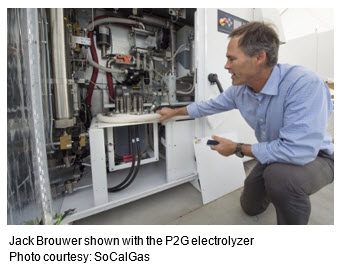WASHINGTON, Dec. 15, 2016 - A technique for converting surplus clean energy from solar panels or wind farms into hydrogen, which can then be blended with natural gas and utilized in “everything from home appliances to power plants,” has been developed by a team of researchers at the University of California-Irvine (UCI).
The so-called power-to-gas (P2G) hydrogen pipeline injection program, has “successfully demonstrated” the use of excess renewable electricity that would “otherwise go to waste,” says Southern California Gas (SoCalGas), which funds the program at UCI.
Jeff Reed, director of business strategy and advanced technology at SoCalGas, says the research lays the groundwork for leveraging the natural gas infrastructure already in place for the storage and transmission of renewable energy.
“As more wind and solar production is deployed, energy storage will be a critical component for grid reliability,” Reed notes.
The central component of the process is the “electrolyzer,” which takes in water and uses excess renewable electricity to power an electrochemical reaction that splits it into hydrogen and oxygen.
The oxygen is released into the atmosphere, and the hydrogen is compressed and sent about 60 feet through a pencil-thin, stainless steel tube to an injection point in UCI’s natural gas pipeline.
There the hydrogen is mixed with natural gas and, shortly thereafter, burned in the gas turbine power plant to generate electricity and heat for the UCI campus.
The renewable fuel can also be converted to methane for use
in a natural gas pipeline and storage system or used in hydrogen fuel cell
vehicles.
“One of the big challenges we’ve faced in adding wind and solar to the grid is what to do with the excess electricity,” says Jack Brouwer, an associate engineering professor at UCI and associate director of its Advanced Power & Energy Program (APEP).
“We've shown you need not halt renewable power generation when demand is low. Instead, the excess electricity can be used to make hydrogen that can be easily integrated into existing natural gas pipeline infrastructure.”
Brouwer says the storage of the hydrogen in existing natural gas infrastructure could become the most important technology for enabling a 100 percent renewable future.
#30
For more news, go to: www.Agri-Pulse.com

